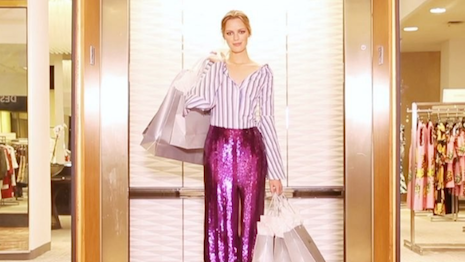- About
- Subscribe Now
- New York,
March 23, 2018

 Affluent consumers are helping premium retailers' revenues grow. Image credit: Neiman Marcus
Affluent consumers are helping premium retailers' revenues grow. Image credit: Neiman Marcus
The increasing gaps in consumers’ incomes and spending power is driving a divide in retail, boosting both premium and value-driven stores as more balanced retailers struggle.
High-end retail revenues grew 81 percent over the last five years, aided by affluents' growing disposable incomes. New research from Deloitte finds that rather than dying, physical retail is instead undergoing changes, opening up opportunities for retailers at the ends of the spectrum.
"Despite the popular narrative, the 'retail apocalypse' is far from reality," said Kasey Lobaugh, principal at Deloitte Consulting and lead author of the report.
"Brick-and-mortar retail is not on or near its deathbed," he said. "In fact, we're seeing retailers open new stores at an astounding pace, and physical retail is growing alongside digital.
"Rather than witnessing the demise of retail, our study shows a dramatic change in line with the impact of consumer bifurcation along economic lines. While specific retailers may see an apocalypse, others see opportunity."
“The great retail bifurcation: Why the retail ‘apocalypse’ is really a renaissance” is based on an analysis of publicly traded retailers as well as a survey of more than 2,000 shoppers from the United States.
Retail renaissance
Since the lowest point during the recession, consumers' collective net worth has more than doubled.
However, this growth has been concentrated at the top, as affluent consumers have seen their net worth rise more rapidly in recent years compared to those who are less wealthy (see story). Deloitte notes that most income growth from 2007 to 2015 was concentrated within the top 20 percent of households.
Only 20 percent of consumers say they have more discretionary income than they did a decade ago. For the 80 percent who say they have less financially flexibility, this leaves less in the budget for non-essential purchases such as fashion.
On the other hand, those with high incomes are 10 percent more likely to say they spent more last year.
High-income consumers' disposable income is aiding high-end retail. Image credit: Bloomingdale's
What has emerged as a result is a retail environment where stores that cater to the well-off with premium merchandise and experiences fare well. On the opposite end of the spectrum, retailers that sell merchandise with a focus on low prices have also succeeded, growing their revenues 37 percent in the last five years.
In the past year, premium retailers have seen the strongest sales growth, with revenues rising 8 percent. Meanwhile, price-based retailers’ sales grew 7 percent and balanced retailers’ sales increased by 2 percent.
Consumers are also more apt to recommend premium or budget retailers to others, further fueling their successes compared to retailers that sit in between them.
In addition to having split interests in where they shop, consumers of varying income levels also hold preferences for different channels. Those with higher incomes are 52 percent more apt to shop online, with 42 percent saying they were more apt to shop via ecommerce in the last three months.
While 52 percent of high-income shoppers turn to online channels to shop, 58 percent of less affluent consumers head to physical stores.
Affluents are more apt to shop online. Image credit: Saks Fifth Avenue
Additionally, high-income millennials are 24 percent less likely than the average consumer to shop in-store.
Despite the growing interest in ecommerce, 91 percent of all retail sales still happen in stores, pointing to a continued life for bricks-and-mortar in the future.
Changing environment
Since 1999, the retail industry has faced declining sales in the wake of falling foot traffic brought about by ecommerce.
Rather than fighting against the ecommerce wave, a report from L2 suggests that retailers need to embrace the possibilities of having both a physical and digital presence to strengthen both entities. This is especially true for high-end department stores, who tend to be less digital-focused than mass retailers.
In addition to balancing bricks-and-mortar and online, luxury retailers are catering to both big spenders and budget-conscious consumers with discounts. A number of department store brands have aggressively expanded their off-price chains, such as Saks Fifth Avenue's Saks Off 5th or Nordstrom Rack (see story).
Retailers have also responded to the growing digital focus of their customers to achieve growth.
Neiman Marcus Group just saw its second consecutive quarter of growth, as the company’s digital investments helped boost its revenues.
The company has been leveraging a “Digital First” strategy across its channels, which is aimed at offering a personalized luxury shopping experience through technology. Today, Neiman Marcus Group’s ecommerce businesses account for 34 percent of its total revenues, and more than 85 percent of its customers’ shopping journeys start online (see story).
"Households have diverged along economic lines and now people's respective income levels are steering their behaviors and dictating the success of retail segments," said Robert Stephens, senior manager at Deloitte Consulting and co-author of the report. "More affluent shoppers have fueled high-end retail as their income and net worth have grown, while lower-earning consumers, faced with growing expenses and dramatically less disposable income, have turned toward price-conscious stores.
"Retailers that try to court all consumers will likely be challenged as income bifurcation leaves different shoppers with differing motivations."
Share your thoughts. Click here